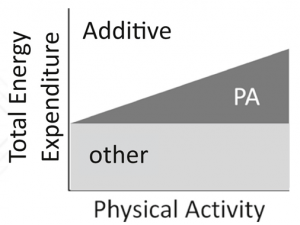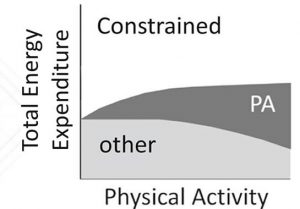Intensity Is Not Always the Answer
by Erik Castiglione
Are you absolutely crushing your workouts in the gym, but still not seeing the results you want from a physique standpoint? Meaning, you come in, hit your WODs as hard as you possibly can, but you still feel pudgy and soft? Sometimes, this can happen, and it can be VERY frustrating. Let’s assume your nutrition is on point, and that you’re getting enough sleep. (If not, START THERE). What gives?
There’s a common misconception that INTENSITY is the be all, end all when it comes to exercise. Orange Theory and other HIIT (high intensity interval training) programs have risen to popularity recently. And, it’s especially common in the CrossFit world, where CrossFit is defined as “constantly varied functional movements executed at high intensity.” So, what is intensity? In physics, it is defined as the time-rate of doing work. In other words, it is work ÷ time. Work is measured in joules, which is a measure of energy. It takes energy to perform exercise at high intensity, and therein lies the draw – because you’re using a lot of energy, it takes a lot of energy to replenish what you’re doing. Let’s assume your goal is fat loss. Theoretically, if you’re eating properly for this goal, performing a HIIT circuit will result in your body replenishing its energy by converting fat stores into usable energy, thereby making you leaner in the process. So why isn’t this the case for everyone?
From a nutrition standpoint, we’ve previously covered that the Energy In/Energy Out equation is a little more nuanced than just exercising enough to burn more calories than you consume. From an exercise standpoint, it’s important to recognize that there is a limit to how much energy we can burn. Yes, it takes energy to fuel exercise. It also takes energy to break down our food and fat stores to have energy available for exercise. These processes are limited by the speed of chemical reactions. Also, from a commonsensical standpoint, it’s impossible to burn energy at an unlimited rate. If that were the case, we could theoretically lose a pound a week until we weighed zero pounds. We know this isn’t the case.

The idea that if we move more, we burn more energy is known as the “additive model.” Conceptually, it seems simple. We all have a certain amount of energy that we burn to simply exist. Doing more than that (e.g. exercising) leads to increased energy expenditure. Based on this model, you would expect people in less developed countries, especially those still living a hunter-gatherer lifestyle to have a higher energy expenditure than people in developed countries. However, recent research has shown that when populations are normalized for weight, this isn’t the case. Instead, energy expenditure is the same.
So, if we can’t keep burning energy without an upper limit, what limits it? Well, the processes the body performs can be broken down into three general categories. The body needs energy for all three, and uses energy in the following priority order:
1. Vital biological functions
2. Physical activity and stress management
3. Tissue repair and adaptation
Your brain determines where to allocate the energy, and of course, the primary function is keeping you alive with vital biological functions. The secondary function can vary A LOT from day to day. If you feel exhausted when you’re stressed out, it’s because your body is using a ton of energy to deal with your stress. This is the one factor most of us don’t take into consideration. Many of us can recall days in high school or college where we had 2-3 hours of practice, plus lifting sessions in the morning for a given sport. Why can’t we do that now? Because we’re stressed out by work, family, finances, etc. We simply don’t have enough energy – we operate in a constrained model of energy, not an additive one.

Which brings us to our main point – if we’re spending all our energy on priorities 1 and 2, we don’t have any left for tissue repair and adaptation. Getting bigger/stronger/leaner are all adaptations, and they require energy. Have you ever heard of women working out so much and so hard that they lose their menstrual cycles? Same thing – their bodies no longer have enough energy to perform non-vital biological functions because energy is being used for physical activity.
So, if you’re not physically adapting to your training, what can you do? Again, assuming sleep and nutrition are on point, you need to conserve energy a bit more. Look at your life outside the gym. If you’re chronically overstressed, you may need to find another outlet in addition to the gym. This could be a gratitude journal, meditation, religion, or whatever works for you. In the gym, are you working out hard for 2 hours, and then hiking/cycling/running on top of that? It might be time to cut back. Or, are you constantly scaling your weights, but finishing the WODs faster than everyone (or in the case of AMRAPs, getting more reps)? Take a step back and look at your performance. Are you performing good reps with full range of motion? If not, SLOW DOWN AND DO IT RIGHT! We don’t care how fast you can go with shitty form. And more importantly, you’re wasting energy without developing the muscles you need for the physique you want. If you already have full range of motion but you’re still super-fast with scaled weights, then it’s time to go heavier. You may need to scale the reps and/or go slower, but that’s fine. It too will dial back on your overall energy expenditure because your muscles will be working harder than your cardio/respiratory system. And therein lies the problem with most HIIT programs – they limit weight. If you don’t increase weight[1], the only way to progress is to do MORE work. And, as we’ve just covered in the last 986 words, there’s a ceiling to the results that will yield. Instead, focus on form, focus on recovery and long-term progress, and talk to a coach if you get stuck. See you in the gym.
[1] Adding in pauses, performing tempo or explosive work, changing stances/positions to work new joint angles would all classify as increasing weight. They provide a novel stimulus to which your body must adapt.

